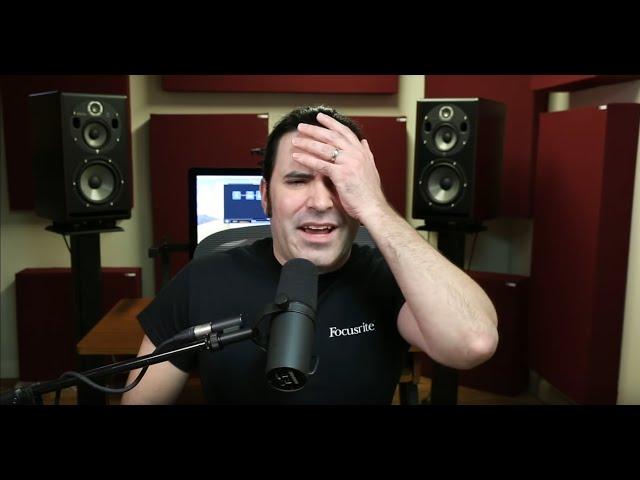
What (Almost) Everybody Gets Wrong About Bit Depth
Комментарии:

Good and interesting overview.
Ответить
For whatever reason, people refuse to believe that noise floor is the ONLY difference. They go on about headroom, clarity, soundstage, "detail" and what have you. There's literally nothing 24 bits can do to improve the sound beyond lowering the noise floor... yes, technically you do get more dynamic range, but you can't utilize it. The noise floor of 16-bit is already effectively silent. If you play the "Noise Floor Test (all bits at "0")" track from the Digital Domain demo CD, you won't be able to tell when it's playing and when it's not!
Ответить
Regarding dither, adding it smooths out the fade of the audio when it gets near the lowest decibel in loudness so that the fade sounds natural, more like it does in analogue. Without dither, those last few seconds of a fade will sound brittle and choppy, the closer one gets to complete silence.
Ответить
Waves plugins, does use 32bit floating processing, like the L1 maximizer has also dither and soundshape possibilities. You can hear it very well, most material we get for mixing are 24bit 48k, we rarely see 32bit and higher than 48k, like 192k, maybe in Atmoz u use these figures, because U have a lot more channels going on? And the master is also rendered to 24bit 48k and sent to the mastering engineer.
Ответить
24/48, FTW (now and into the foreseeable tech future; for just music AND film purposes) ………. ?!?!?! 😬
I remember some people saying they used 88.2 (over 48 or 96), because it was exactly double 44.1, so when they exported at 16/44.1, ‘rounding errors’ that might/would otherwise occur when exporting from other sample rates were avoided (they may well have recorded in 32-bit, as well, rather than 24 … ‘because it’s easier for a computer to just halve data, rather than multiply by 2/3’ … 🙄😏 … and/or ‘because it somehow avoids rounding errors’).
… No doubt, they were concerned about quantizing … but, given how good computers are at math, that sounded like nonsense then, and it still does now … ?!

Moment he said 48 bit, I stopped watching.
Ответить
I"m a computer engineer who makes sound cards. I guess MAYBE you can describe it as noise floor, but it's not accurate: the circuitry around the converter determines the noise floor. 24-bit allows you to record quieter sources and capture UP TO 144db dynamic range, compared to 96db dynamic range for 16-bit. If your mic has a lot of self-noise, then 24-bit won't help you because the mic is determining your noise floor. If you have a cheap sound card like Behringer UMC202/UMC204/UMC404, then the circuitry around the ADC/DAC is low quality and won't sound as good as a MOTU. Cheap op-amps destroy the audio quality. The benefit of 32-bit audio is it's in floating-point format, which is trivial to convert from 24-bit to 32-bit float, so it's kind of a gimmick but not useless. The biggest benefit of 24-bit is that you can keep your mic gain lower, avoid using a cloud lifter for that SM7b, and you can use digital gain. The way that audio software works is they bit shift the 16-bit, 24-bit audio samples so they're 32-bit (i.e. the MSB gets shifted to the 32-bit; bit shifting is a single-cycle instruciton), so 32-bit is technically a little bit lighter on your CPU but won't be noticeable unless your CPU is peaking.
Ответить
Mabybe someone here can asnwer this question. I get that bit depth directly translates into a certain db range. I think its 6db per bit. I don't understand how that range is divided. What is the smallest amount of difference possible between to amplitude values? The video says that resolution is not applicable but It seems like there would need to be discrete levels or steps to changes in volume.
Ответить
it sounds like working in 32-bit is the audio equivalent of using RAW files, HDR (beyond what can be displayed), or super high resolutions/quality in visual art. Not perceptible or maybe even transmittable in the final product, but keeps you safe for any crazy nonsense you want to do until that final mixdown/render. Thanks for the explanation!
Ответить
If you encode the same exact audio recording in 24 vs 16 bit, is there more quantization error in 24 bit vs 16 bit?
Ответить
Excellent review but Vst now adays doesn’t support this n rather there r issues related to programming..
Ответить
Kind of mind blowing, sound really is just time and intensity. Our ears have just evolved to take note of the quick pressure changes caused by the creatures and objects moving around and vibrating the air when they do, like ripples in the ocean.
Ответить
here comes another know all talking about dynamic ranges.... omg! they do miss the point dont they...
Ответить
Could you explain how a bit crusher works and how it relates to this? Thanks!
Ответить
Awesome video, just as valuable as the sample rate one!
Ответить
No 32bit capture devices exist? Aren't ALL of Steinberg's interfaces maxed out at 32bit???
Ответить
I have a question about an analogy I read. Pooring 16 milliliters into a 32 milliliter bottle. That means that other 16 milliliters of space is just silent waste, so when truncate back down to 16 bit... Does it try to include the wasteful air and get squashed with the 16 milliliters in the same 16 bit size? Or is that empty space discarded thus making 32 bit perfectly harmless for upconversion? VirtualDub2 doesn't have a 24 bit options and I'm dealing with WMA SRS audio so I'm concerned. It was only until recently that AviDemux 2.8.0 got WMA Lossless and I'm on 32 bit Windows so I can't use it. Encoding Spirited away for my XT2041DL via VP9+Opus.
Ответить
Yeah.
I can't hear audio dithering, and also the difference between 24-bit and 16-bit audio files, but I do hear the difference between 44.1kHz and 48kHz+
So, sample rate does matter (to some degree).

Thank you very much for this video. So working in 44,1 khz - 16 bits is enough and the best compromise (quality/cpu ressources) ?
My computer is quite old so it suits me, and no need dithering !

You've perfectly articulated why I use 32 bit only for recording and processing, and save everything down to 16 bit (although I'd prefer to do everything in 24 bit just to guarantee there was no way to find the noise floor; I'll explain in a second).
I run an internet radio station. I prepare files for airplay by centering audio files, setting peaks to 100% (actually I set at -0.1 db to avoid clipping when converting back to 16 bit), and trimming the opening and closing. Often I create edits and early fades to match the original promo edits of the songs I play.
I sincerely thought when I was editing in 32 bit I was in a kinda of "fantasy" bit depth where it's impossible to clip and there's no noise floor. I've never had a peak clip, even at absolutely insane, extreme settings and levels. It makes me feel like I can't make a level error that can't be corrected with re-adjusting the peak back down (or up) to 100%. That made it perfect for editing, because no matter what I apply, I'm not adding noise or distortion.
The other benefit of 32 bit is that with my station, I have broadcast-style multi-band audio processing working overtime to recreate that big, pumpy, 80s FM radio sound. (OK, I'm not quite as aggressive as the 80s stations were with things like composite clipping... but my internet station is loud, which isn't supposed to be a thing.) One of the things I make sure the system does is pull up fades as much as possible to create that "wall of sound" effect they had where the music never stopped.
When you have a song slowly fading out, and another slowly fading in, you may be pulling the volume up 40db to 60 db. Suddenly that 96 db noise floor is at 36 db. Doing all I can to avoid adding any noise to that sort of situation is a good thing.
...Now, once I've got everything cleaned up and the file is set at -0.1 db, I convert back to 16 bit. :-) As you said, NOBODY (not even with compression) is going to hear the 96 db noise floor... especially when most of these recordings are from analog studio tape that probably had a 60 db S/N ratio anyway.
Your explanation was outstanding, and clarified so much about bit depth that is so often presented across the internet in very muddy terms. Thanks for your efforts!!

Remember that compression brings up the noise floor.
Ответить
Dither is noise that is added on purpose to reduce the distortion caused by down sampling to lower bit depth.
Ответить
So it would be like taking pictures with a camera using raw vs jpeg, where raw gives you more room for error correction but it will be finalized as a jpeg to be consumed afterwards just like recording at 24 bit and then converting it to 16 bit for consumption just as sharing a raw file with people would be overkill unless it's for them to work with in a program? Also I'd like to think of the kbps for mp3 the difference between a very noisy jpeg image vs one that has very little noise but at some point the noise will be too low notice anyways unless one wants to really push to look for it. So probably 320kbps is about as clean as I imagine it can get as far as most people's listening equipment. I've been getting Flacs from Bandcamp albums that I've purchased but it's really hard to tell the difference if there really is any. Mainly I just have the storage space for it and a portable player that can play them back and has a headphone jack so I can use it without Bluetooth if I want and supposedly has a nice dac in it. The reason I looked up this video is because there is 24 bit recordings of Linkin Park but I know that it's just going to still still have constant soundness because of the loudness war and what is the point of even paying more for such recordings when it's still sound pushed to the threshold of just below clipping the sound, at least that's what I imagine how those CDs were recorded. I don't think Linkin Park has any quiet sound, it's just full throttle xd.
Ответить
Well and very good for a setting wherein you get to predesign and adapt your sound design to your specific capture goals, but what of the cases when you need screaming, clanging, uncontrolled environments, or you mean to capture live Foley that's cracks that noise ceiling? It seems to me like the bias of being an expert in sound makes the issues given by limited un-clipped sound range less and less of an issue. As you say "you get to be sloppier," and, yes, yees but that's critically important headroom for those of us without all the appropriate equipment and training to capture whatever we're going to need to capture. (and, presumably know and prepare in advance not to clip when one of our actors goes into a primordial tantrum, screaming out the pain of the community theater smalltown life to an ill-suited-to-the-job dynamic mic they left at the table & across the room from the condensers on the interface.
Ответить
The only real reason to use 32-bit intermediate audio files is exactly the same as using it internally within the DAW: it’s possible in your processing or mixing to do something that pushes the intermediate output over 0db, in which case you could end up writing an intermediate file that contains clipping, which is then very hard or impossible to fix. I learned this the hard way once…
Ответить
I think you have not mentioned that some recorders use a dual A/D converter to overcome the 120db dynamic range limitation of the analog circuits when recording in 32 bit float. Each of the A/D converters covers a different range than the other. That way it is possible to achieve a true widest dynamic range.
In field (location sound) recording sometimes it is invaluable to have room to be able to recover from extreme situations. A good example would be a shoot and run documentary. In some occasions being able to get a whisper back to an intelligible level without touching the noise floor is crucial. The same goes when you can recover a very loud source without clipping.
Thanks!

This is by far the best video explanation of everything related to bit depth, with a little history added to help you understand even more. Also thank you for being so unbiased to the whole thing. Its rare to find videos and people like you out there lol.
Liked and subscribed (:

Correct me if I am wrong but are you not coding an analogue wave form (ie the superposition of all harmonics/acoustic reflections/phase etc.. ) in to a digital representation of it using bit depth and sample rate, yes ?? Then bit definition (as well as sample rate) will determine how well you are able to rebuild that wave form. By not having sufficient steps (ie bits) are you not restricting the resolution of fine detail (this equates to harmonics and stereo spatial placement) of the rebuilt wave form. If you do a spectrum or Fourier analysis of the original wave form and restructured waveform. Do a comparison. Do this at different bit depths and see what you get. Look forward to your comment.
Ответить
If I record an instrument (for example a guitar) using a 32 bit audio interface does this make the hum noise more quiet?
Ответить
Great video, Tnx
Ответить
Vinyl and tape being 6-8 bits might work for a noise floor dynamic range but you can’t record even at 12bit without it not sounding as good as 16. So isn’t there more to it than just “noise floor dynamic range”? I’d love to know what that means as far as how that applies when you go further up? Also if I record in 24bit on pro tools you’re saying my plugins etc are still being used at 32? Thanks so much for this video and the sample rate video. Super informative!
Ответить
ok so 48 fixed point bit isn't as forgiving as 32 floating bit point (I tend to get a bit heavy handed and sloppy and when I 'transfer to audio' in studio one lots of channels clipping sometimes 10db etc sometimes no digital internal clipping when I 'transform to audio' (once my cpu is maxed I tend to bounce stuff off, integrally.
I can relax about the ceiling being chopped off! (I like emulating slamming and smacking an analog desk in the box lol -
But how about 64bit float? Studio One has an option for 64bit flooring point, I will use it and see what its like. :) - any issues, then Ill put it on 32 bit flooring pint (im heavy handed style i.e. sloppy :) )

I have seen that recorders like Sound Device records in 32bit, and are really usefull for not having so much noise in dialogues. ¿What about this?.
Ответить
Many Thanks Justin !! I've learnt a lot Today !! Think I've finally understood what goes on !! Your A Great Teacher !!
Ответить
Very insightful, thank you!
Ответить
Bit depth... you don't even know it's there until you go to apply digital gain aka you digitally amplify it. When your recording a master get as much of that resolution that you can for applying effects. For example if you try to digitally quadruple the volume of something quiet then you will be grateful for 64bit sampling. But on playback ment for human ears don't bother with more than 16/24 bit.
Ответить
Thanks for such a nice explanation! I had a question on exam where I missed some points! Could anyone please explain it to me!
The question is: signalfrequency is 20-20000hz, samplingfrequency is 45000hz, bit depth is 8bit all coded with pcm. What can you tell about the signalquality from above mentioned?

bro chill with the sponsors put em in the end geez
Ответить
you are high as a kite
Ответить
I had a Boss 16 track recorder and it was 24 bit 48 but I couldn't figure out why after about 6 tracks it started sounding muddy and cloudy, it was after I got rid of it I discovered that after so many tracks it reverted to 16 bit so no science or explanation on earth can convince me bit depth doesn't matter
Ответить
Now 64 FP it's best option for DAW engine processing! Google what is double precision engine and how it works. I'm talking about DAW MIXING ENGINE ONLY now! Reaper, Logic and Cubase can run it. Best sounding plugins already switch they engines to 64 FP too (Acustica, Slate, Sonnox etc). Little harder on the CPU but it's worth it. A lot less errors in processing and summing and end results are cleaner and better. Do your own tests, check it and don't believe my words before you try it by yourself. Outtie
Ответить
Wow! you explained it like a knife slicing through butter! You're awesome, Thank you!
Ответить
You said that your not telling us not to dither. But you also said that you can only hear it if its turned up to unrealistic level. So there's no point in doing it really? But still do it lol. Thanks though. Great info ! I listened to this a couple years ago. But it finally really makes sense now.
Ответить
wow. what can i say. i am no professional, but listening to this entire video, i am completely satisfied at the answers you've patiently explained. thank you so much. i truly get it now, and i can't wait to see what else i can learn from your videos!!!
but... with my Rhode NT1 and Yamaha MG10XU mixer, what is the best way to eliminate as much noise as possible? i have a Mogami Gold mic cord and laptop/mixer and all plugged into a surge suppressor that filters RFI. the mixer outputs 24bit/192kHz audio via USB, but is it comparable to/inferior to an audio interface around the $200 price point? (concerning noise floor.)



![Cоздаю Презентацию и Показываю Процесс | [6 СЛАЙДОВ] для мобильного приложения Cоздаю Презентацию и Показываю Процесс | [6 СЛАЙДОВ] для мобильного приложения](https://invideo.cc/img/upload/OG1maDZlWEg5TjQ.jpg)







![[ IDK I JUST PUT MY FRIENDS IN MY TUB ] // Feat. TYLER SCHEID [ IDK I JUST PUT MY FRIENDS IN MY TUB ] // Feat. TYLER SCHEID](https://invideo.cc/img/upload/TVRfS3cwanpwNzM.jpg)














